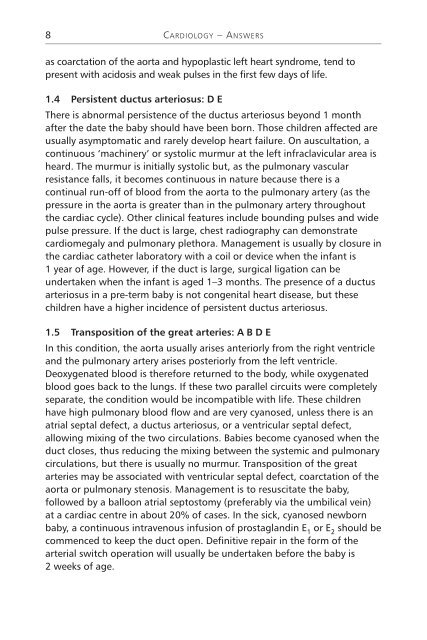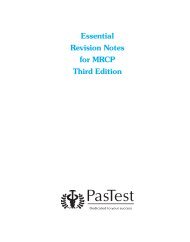MRCPCH 1: Essential Questions in Paediatrics - PasTest
MRCPCH 1: Essential Questions in Paediatrics - PasTest
MRCPCH 1: Essential Questions in Paediatrics - PasTest
- No tags were found...
You also want an ePaper? Increase the reach of your titles
YUMPU automatically turns print PDFs into web optimized ePapers that Google loves.
8CARDIOLOGY – ANSWERSas coarctation of the aorta and hypoplastic left heart syndrome, tend topresent with acidosis and weak pulses <strong>in</strong> the first few days of life.1.4 Persistent ductus arteriosus: D EThere is abnormal persistence of the ductus arteriosus beyond 1 monthafter the date the baby should have been born. Those children affected areusually asymptomatic and rarely develop heart failure. On auscultation, acont<strong>in</strong>uous ‘mach<strong>in</strong>ery’ or systolic murmur at the left <strong>in</strong>fraclavicular area isheard. The murmur is <strong>in</strong>itially systolic but, as the pulmonary vascularresistance falls, it becomes cont<strong>in</strong>uous <strong>in</strong> nature because there is acont<strong>in</strong>ual run-off of blood from the aorta to the pulmonary artery (as thepressure <strong>in</strong> the aorta is greater than <strong>in</strong> the pulmonary artery throughoutthe cardiac cycle). Other cl<strong>in</strong>ical features <strong>in</strong>clude bound<strong>in</strong>g pulses and widepulse pressure. If the duct is large, chest radiography can demonstratecardiomegaly and pulmonary plethora. Management is usually by closure <strong>in</strong>the cardiac catheter laboratory with a coil or device when the <strong>in</strong>fant is1 year of age. However, if the duct is large, surgical ligation can beundertaken when the <strong>in</strong>fant is aged 1–3 months. The presence of a ductusarteriosus <strong>in</strong> a pre-term baby is not congenital heart disease, but thesechildren have a higher <strong>in</strong>cidence of persistent ductus arteriosus.1.5 Transposition of the great arteries: A B D EIn this condition, the aorta usually arises anteriorly from the right ventricleand the pulmonary artery arises posteriorly from the left ventricle.Deoxygenated blood is therefore returned to the body, while oxygenatedblood goes back to the lungs. If these two parallel circuits were completelyseparate, the condition would be <strong>in</strong>compatible with life. These childrenhave high pulmonary blood flow and are very cyanosed, unless there is anatrial septal defect, a ductus arteriosus, or a ventricular septal defect,allow<strong>in</strong>g mix<strong>in</strong>g of the two circulations. Babies become cyanosed when theduct closes, thus reduc<strong>in</strong>g the mix<strong>in</strong>g between the systemic and pulmonarycirculations, but there is usually no murmur. Transposition of the greatarteries may be associated with ventricular septal defect, coarctation of theaorta or pulmonary stenosis. Management is to resuscitate the baby,followed by a balloon atrial septostomy (preferably via the umbilical ve<strong>in</strong>)at a cardiac centre <strong>in</strong> about 20% of cases. In the sick, cyanosed newbornbaby, a cont<strong>in</strong>uous <strong>in</strong>travenous <strong>in</strong>fusion of prostagland<strong>in</strong> E 1or E 2should becommenced to keep the duct open. Def<strong>in</strong>itive repair <strong>in</strong> the form of thearterial switch operation will usually be undertaken before the baby is2 weeks of age.
















